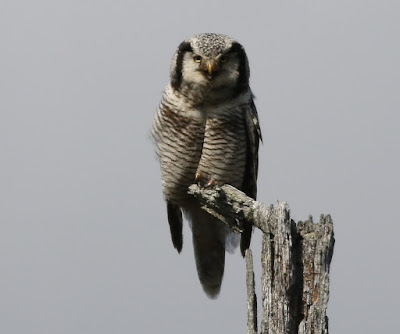I was half way through the second Finnature trip on my Owl trip to Finland with Mark Edgeller, Andy Rhodes & Simon Ingram. It was only 06:30 in the morning, but we had met the guide Olli at 03:00 & been at a hard Birding pace since we started. In the previous Blog Post, I had covered some of the crazy species seen including a Willow Grouse sitting on a lamp post & very close views of a male Capercaillie. But we had come to Finland for its Owls & so far we had seen only three of the five key species: Pygmy Owl, Ural Owl & Great Grey Owl on the first Finnature trip in the Oulu area. We had also seen a Short-eared Owl, but that didn't count as they aren't hard to see in the UK. Our final two target Owls were Tengmalm's Owl & Hawk Owl. I had seen Hawk Owl before after twitching one in the centre of the small town of Zwolle, Holland in Nov 13, but it was a Tick for Simon. As Hawk Owls are such cracking Owls, I was keen to see another. Fortunately, Olli said the right words when we met, that he knew a site where we can see a Tengmalm's Owl & we will start by looking for that first. Both of the small Owl species are happy to nest in nest boxes & by the start of June, they are bringing food to the chicks. There is little chance of upsetting their breeding cycle by brief visits to the nest box at this time of the year. The only drawback is the light was very poor & I was trying to hand hold an unstablised 400mm lens on ISO 10,000.
Next on the itinerary was Hawk Owl. The numbers of breeding Owls fluctuate annually, depending on fluctuations in Vole & Lemming numbers. This year, the numbers of breeding Hawk Owls weren't high, but Olli had a site a few miles before the Russian border. It was a bit of a drive, but worth it. It was such a remote site, we could have spent a month trying to find this pair without local information.
Tengmalm's Owl: This nest box was near to a quiet road where we waited. Olli walked over & scratched the tree, which was the cue for his friend to appear
Tengmalm's Owl: This is the nominate funereus subspecies which occurs from Scandinavia to the Pyrenees & the Urals. The overall range of Tengmalm's Owl is huge as it is occurs in all the conifer forests across Northern Europe to China & Alaska, Canada & the Northern US (where it is called Boreal Owl)
After looking for the Willow Grouse, Black Grouse & Capercaillie (see the previous Post), it was time to head off to look for Siberian Tit. This was another nest box stakeout.Next on the itinerary was Hawk Owl. The numbers of breeding Owls fluctuate annually, depending on fluctuations in Vole & Lemming numbers. This year, the numbers of breeding Hawk Owls weren't high, but Olli had a site a few miles before the Russian border. It was a bit of a drive, but worth it. It was such a remote site, we could have spent a month trying to find this pair without local information.
Hawk Owl: Olli said the youngsters of this pair has recently fledged. We decided to stick with the parents, rather than cause them concern by looking for the youngsters
White-tailed Sea-eagle: Adult
By late morning, we were back in Kuusamo. We had enough time for a leisurely drive back to Oulu to catch the plane home to the UK. Our short four day trip was over, but it had been a good trip & four days was long enough. If you are planning a trip to Finland at this time of year, I can thoroughly recommend booking the guided trips at Oulu & Kuusumo with the Finnature guides. They seem expensive for an eight hour long morning, however, they will have most if not all of the speciality species staked out. But book early to ensure you can get onto a trip as spaces are limited. Finland is such a vast area & it would be very time consuming to try finding these species without very good local information. However, as a cost-effective compromise, you can hire cars at a reasonable price & driving in Finland is easy. There is plenty of self-catering accommodation available online. Therefore, it is reasonable to book the two Finnature trips & have a few days Birding on your own seeing the easier species. There were a few other Scandinavian goodies I didn't see, but they occur several hundred miles further North. They were Pine Grosbeak, Brunnich's Guillemot, King Eider & Steller's Eider. However, these are best seen by a trip to Varanger Fjord in Norway. I've seen all of these species as vagrants in the UK over the years, but I am still tempted to go to Varanger Fjord for a few days at some point in the future. One final thought, I wish I had bought one of the mozzie head nets before the trip. Olli lent us some for the final morning & having one for the rest of the trip would have been good.












